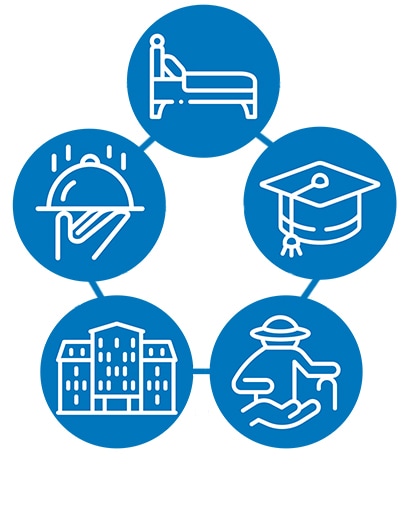Helping Offset the Labor Squeeze and Tightening Operations: A Partnership Perspective
Labor challenges continue to impact many industries and business segments

Labor challenges continue to impact many industries and business segments. And the cruelest irony? That some of the most significant shortages are hitting areas where demands are higher than ever: the workers responsible for helping keep spaces clean, healthy and safe — are also those shouldering the burden of higher expectations around public health and food safety. With signs suggesting these trends aren't going anywhere, the most successful business operators are uncovering key strategies for empowering staff, simplifying workflows, and driving labor efficiency, without compromising experiences, facility safety or brand image.
Labor “shortage” shaping up to be the new normal
A survey by the Society for Human Resource Management from mid-summer 2021 found that nearly 90% of employers across all sectors are struggling to fill open positions1, and it’s not that hard to figure out why: There are roughly three million fewer Americans currently participating in the labor force than pre-pandemic2. The exodus from the workforce isn’t letting up, with monthly “quits” hitting new highs, according to the most recent U.S. Bureau of Labor Statistics report3. There are several pandemic-related reasons still driving the exodus, from direct health and safety concerns to increased childcare burdens. But many other factors appear more permanent. The rate of retirement jumped significantly over the last year, with more than half a million more retirements than expected between May 2020 and April 20214.
In fact, this is part of a larger trend that has been forecasted for years. The working-age population in the U.S. — which continually increased over the past 40 years — appears to have peaked in mid-2019 and began falling well before the pandemic5. The cause: a combination of retiring baby boomers, declining birthrates and lower immigration that will create what one economic analyst group is calling the “Sansdemic.”
The skills gap hurts just as much
With more senior workers leaving the workforce, the problem for many businesses is not — or is not only — a labor shortage; it’s the skills gap. The declining average age of the U.S. workforce means job applicants may be coming with less experience. And with the “Great Reshuffling” — LinkedIn says more than half of job changes this summer were from one industry to another6 — meaning more job applicants may be coming in with little or no relevant experience. That means additional time and cost to train new workers on things like the difference between sanitization and disinfection, or proper food safety protocols. Add this all up at a time when most people say they’re more focused on hygiene and sanitation in businesses7 — and 95% of consumers say they still want to see as much or more cleaning as before vaccines became available8 — and you’ve got another serious pressure added to the overall labor squeeze.
Doubling down on labor efficiency and customer experience
In most businesses, labor costs have always been a top concern. But now — juggling additional requirements to meet rising customer concerns and expectations, a shortage of experienced labor to do that work, and higher costs for the workers they do have — labor efficiency is the make-or-break focus in just about every business. Some business operators are finding quick-win opportunities by doubling down on enhancing their cleaning programs. Rather than cutting corners, they’re implementing creative strategies and innovative products that help them achieve a higher level of cleanliness — more efficiently.
3 Key Strategies for Driving Labor Efficiency
in Cleaning
1. SIMPLIFY: Make facility cleaning protocols simple to learn
and execute
- Select multi-purpose solutions: SARS-CoV-2 (the virus that causes COVID-19) is not the only pathogen putting your patrons and business at risk. Select an EPA Registered disinfectant with a broad set of claims and efficacy against other key disease-causing pathogens like Norovirus, Influenza, salmonella and other bloodborne pathogens.
Further, products that can be used on multiple surface types and/or that can do multiple jobs in a single step (i.e. clean AND disinfect) can save your staff time and eliminate the need to switch between various cleaning solutions. This includes products like multi-surface cleaner/disinfectants that do not require pre-cleaning, as well as no-rinse products like floor cleaners that dry quickly and residue-free to eliminate the need for an additional rinse step. - Find products with shorter contact times: Antimicrobials (such as sanitizers or disinfectants) are only effective when the treated surface remains wet for the complete contact time. Opting for a product with a shorter contact time not only drives efficiency — when paired with proper training, shorter contact time helps staff more reliably follow proper procedures, so you can feel more confidence in the results.
- Consider alternative application methods: Products approved for use with electrostatic sprayers can enable more efficient application, particularly in large spaces. Easy-to-use formats like wipes allow for convenience and flexibility in application.
2. STREAMLINE: Make it fast and easy to clean the “right way”
- Seek out a standardized product list across locations: Just like you streamline your menus, ingredients, across locations for guest experience and operational efficiencies — your cleaning program should be no different! Having a brand standard cleaning program simplifies your ordering, inventory management, procedures, training, and more — supporting consistent outcomes with less hassle.
- Arm your team with innovative cleaning equipment: Professional-grade cleaning tools that are designed with ergonomics and high-volume use in mind offer innovative features that can accelerate cleaning times. Certain systems combine a high-performance cleaning product with an ergonomically designed foaming tool that can help reduce physical exertion and bathroom-cleaning time. Other professional-grade tools feature interchangeable heads with easy-on and -off mechanisms that help enable workers to shave minutes off every day cleaning tasks — savings that add up quickly.
3. SHOW THEM HOW: Prioritize onboarding and ongoing training
With the skills gap growing, a recent survey found that 1 in 3 frontline workers say lack of training is their biggest challenge14. Making an investment in better, more frequent staff training is a strategy that can pay off quickly and continually in the form of greater labor efficiency.
- Make training flexible: Consider digital training platforms that let workers complete training modules on-demand, anytime, anywhere. Look for partners that can also come on-site when needed to supplement digital training with targeted in-person staff support.
- Make training highly visual: Try using video-based training, on-site demonstrations and highly visual guides at the point-of-use to enable workers to understand more intuitively the “what” and the “how” of proper cleaning protocols. These methods can also help reduce language barriers.
- Make cross-training a priority: Use slow periods for hands-on coaching or to cross-train workers from different teams on basic cleaning protocols. During the next slow period, they can put that training to action. Cross-training can help boost labor efficiency and operational flexibility.
Lean on vendor partners to ease the labor squeeze
Many businesses are already implementing these tips to help improve labor efficiency. The businesses who do it well often lean heavily on their vendor partners to help them make these strategies a reality. For example, Ecolab is working with customers across all sectors to help them put the right products and procedures in place — and help them train their workers. The outcome? Helping businesses to ultimately meet higher expectations for their customers and brand, while also helping protect their bottom-line potential.
- https://advocacy.shrm.org/wp-content/uploads/2021/07/SHRM-Research_The_Employment_Picture_Comes_Into_Focus.pdf
- https://www.ncci.com/SecureDocuments/QEB/Insights-2021-Q2_LaborShortage_2021.html
- https://www.bls.gov/news.release/empsit.nr0.htm
- https://www.ncci.com/SecureDocuments/QEB/Insights-2021-Q2_LaborShortage_2021.html
- https://fred.stlouisfed.org/graph/?g=Ex8I&utm_campaign=JM-305&utm_content=rw96476r&utm_medium=ED&utm_source=for
- https://www.usatoday.com/story/money/2021/09/07/labor-day-2021-when-worker-shortage-end/5674223001/
- https://www.ey.com/en_gl/consumer-products-retail/how-to-serve-the-anxious-consumer-after-covid-19
- Post-Vaccine Consumer Attitude Study,” January 5, 2021 (paid for by Ecolab)
- https://advocacy.shrm.org/wp-content/uploads/2021/07/SHRM-Research_The_Employment_Picture_Comes_Into_Focus.pdf
- https://advocacy.shrm.org/wp-content/uploads/2021/07/SHRM-Research_The_Employment_Picture_Comes_Into_Focus.pdf
- https://advocacy.shrm.org/wp-content/uploads/2021/07/SHRM-Research_The_Employment_Picture_Comes_Into_Focus.pdf
- https://advocacy.shrm.org/wp-content/uploads/2021/07/SHRM-Research_The_Employment_Picture_Comes_Into_Focus.pdf
- https://www.bls.gov/news.release/empsit.nr0.htm
- https://www.prnewswire.com/news-releases/survey-digital-workplace-key-to-engagement-for-frontline-teams-301249880.html




